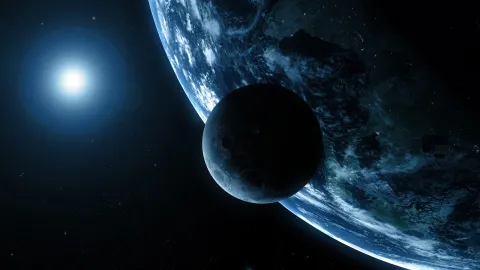The moon drifts 1.5 inches (3.8 cm) away from Earth annually, gradually lengthening days.
Key Takeaways
- Earth’s days lengthened by 2.2 hours due to the moon drifting farther away.
- Extended daylight might have sparked oxygenation events, enabling life to evolve more complexly.
- Researchers identified two periods of rapid rotational change in Earth’s history using tidalite data.
- The moon moved 12,000 miles farther during these periods, altering tidal and solar dynamics.
- These shifts coincided with the Cambrian explosion and periods of extensive glaciation.
_____________
The Moon’s Influence on Earth’s Evolution
Earth’s days weren’t always 24 hours long. According to a study published in PNAS, the length of Earth’s days increased by over two hours due to the moon’s gradual migration away from the planet. This celestial phenomenon may have significantly impacted life on Earth, particularly during key evolutionary and geological events.
The moon currently orbits at an average distance of 238,855 miles (384,400 kilometers), but its position has changed dramatically over billions of years. As the moon tugs on Earth’s rotation, it slowly moves farther away, siphoning energy from the planet’s spin and extending the length of days.
New Insights from Tidalite Data
Led by geologist He Huang of the Chengdu University of Technology in China, the research team aimed to refine Earth’s rotational history by analyzing rock formations known as tidalites. These marine sediment layers, dating back 700 million to 200 million years ago, provide clues about tidal forces and Earth’s spin over time.
The study uncovered a “staircase” pattern in Earth’s rotation, with two significant periods of rapid change followed by stability. The first period occurred roughly 650 to 500 million years ago, coinciding with the Cambrian explosion — a pivotal era when life diversified into complex forms. The second period, from about 340 to 280 million years ago, aligned with a glaciation phase when massive ice sheets blanketed Earth.

During these intervals, Earth’s days lengthened by 2.2 hours, while the moon moved approximately 12,000 miles (20,000 kilometers) farther away. These shifts likely redistributed solar energy, altering temperature gradients and atmospheric dynamics.
Implications for Life and Climate
The study suggests that longer days increased sunlight exposure, potentially driving oxygenation events that laid the foundation for complex life. However, the authors caution against overinterpreting the results. While extended daylight likely played a role, other environmental and biological factors also influenced life’s diversification.
Interestingly, the researchers disputed a previously held notion that glaciation events significantly impacted Earth’s spin. Instead, they concluded that tidal forces were the primary driver of the slowdown in Earth’s rotation.
The findings underscore the intricate interplay between celestial mechanics and Earth’s environment, revealing how the moon’s subtle influence shaped our planet’s history.




